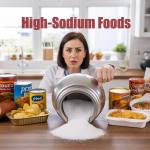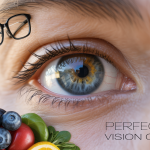Vitamin B2, also known as riboflavin, is a water-soluble vitamin that keeps your body’s energy production and cellular repair running smoothly. This essential nutrient plays a crucial role in converting food into fuel and maintaining healthy skin, eyes, and nervous system function.
This guide is perfect for health-conscious individuals, busy professionals, and anyone wanting to understand how riboflavin impacts their daily wellness. Whether you’re experiencing fatigue or simply want to optimize your nutrition, you’ll discover practical insights about this vital B vitamin.
We’ll explore riboflavin’s key functions in your body and reveal which everyday foods pack the biggest B2 punch. You’ll also learn to spot the warning signs of riboflavin deficiency and get actionable tips for meeting your daily needs through smart food choices and safe supplementation.
Understanding Riboflavin’s Essential Role in Your Body
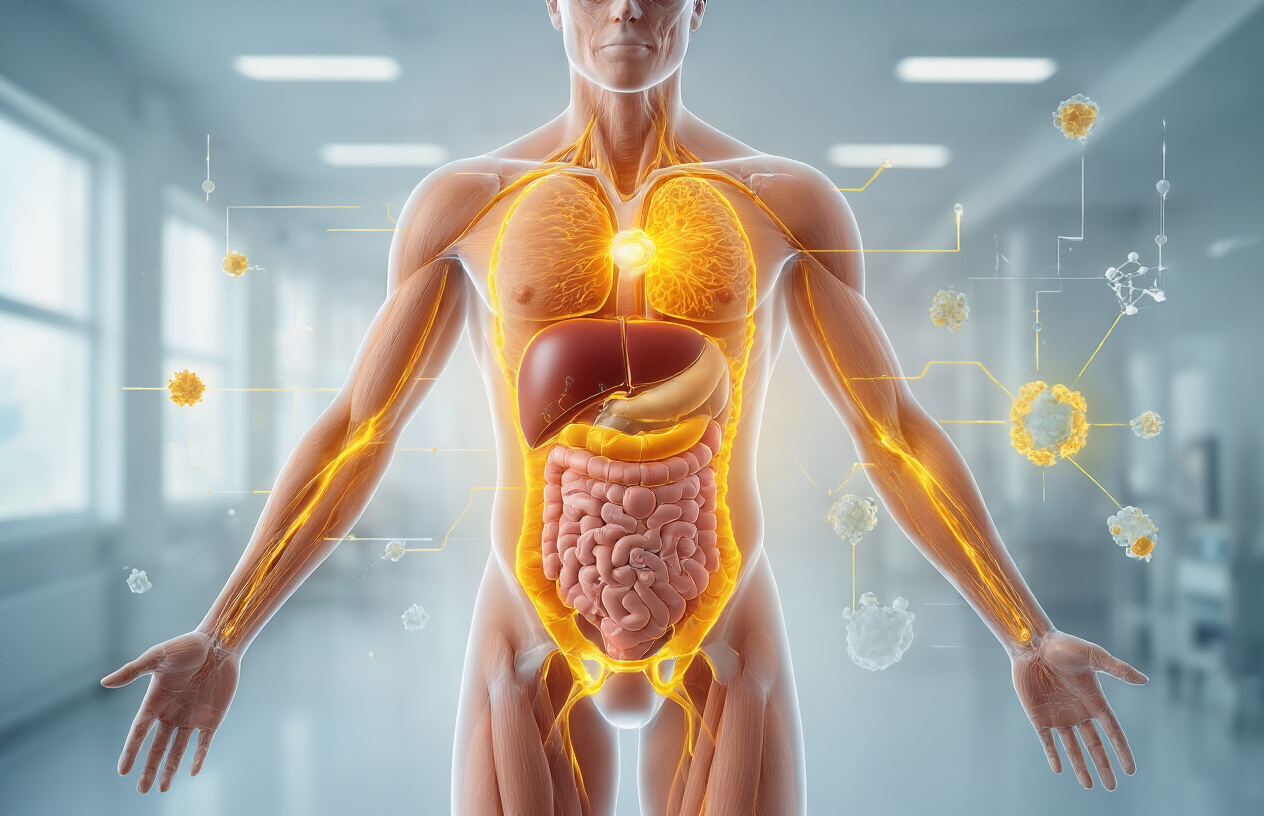
Discover How Vitamin B2 Powers Your Cellular Energy Production
Riboflavin works like a tiny engine inside every single one of your cells, converting the food you eat into usable energy. This water-soluble vitamin transforms into two active coenzymes – flavin adenine dinucleotide (FAD) and flavin mononucleotide (FMN) – that act as essential partners in your body’s energy production assembly line.
These coenzymes grab onto electrons during the breakdown of carbohydrates, fats, and proteins, shuttling them through a complex series of chemical reactions known as the electron transport chain. Think of riboflavin as the spark plug that ignites your cellular powerhouse, the mitochondria. Without adequate B2, your cells struggle to produce ATP, the energy currency that keeps everything running smoothly.
Your muscles rely heavily on this process during physical activity. When you exercise, your riboflavin-dependent enzymes work overtime to meet increased energy demands. Athletes and active individuals often need higher amounts because their cellular engines run at full throttle more frequently.
The beauty of riboflavin’s role lies in its efficiency – it doesn’t get consumed in these reactions but rather acts as a reusable catalyst, making the same coenzyme molecules available for thousands of energy-producing cycles throughout the day.
Learn Why Your Body Cannot Store This Vital Nutrient
Your body treats riboflavin like a daily guest rather than a permanent resident. Unlike fat-soluble vitamins that can be tucked away in fatty tissues for months, riboflavin dissolves easily in water and gets flushed out through your urine within hours of consumption.
This water-soluble nature means your body maintains only small reserves – roughly enough to last just a few weeks if you suddenly stopped consuming B2 entirely. Your kidneys work efficiently to filter out excess riboflavin, which explains why your urine might turn bright yellow after taking B-vitamin supplements.
The constant turnover creates a daily dependency on dietary sources. Your body can’t manufacture riboflavin from scratch like it does with some other nutrients, making you completely reliant on external sources. This biological reality explains why riboflavin deficiency can develop relatively quickly compared to deficiencies of stored nutrients.
Pregnancy, illness, stress, and certain medications can accelerate riboflavin depletion, creating situations where your daily needs spike beyond normal dietary intake. Your body prioritizes essential functions when supplies run low, potentially leaving less critical processes struggling without adequate B2 support.
Understand Riboflavin’s Critical Function in Metabolism
Riboflavin acts as a metabolic multitasker, supporting far more than just energy production. This versatile vitamin plays starring roles in breaking down all three macronutrients – carbohydrates, fats, and proteins – through different enzymatic pathways.
For carbohydrate metabolism, riboflavin helps convert glucose into energy through glycolysis and the citric acid cycle. With fats, it assists in beta-oxidation, the process that breaks down fatty acids to fuel your brain and muscles during extended periods without food. Protein metabolism relies on B2-dependent enzymes to recycle amino acids and eliminate nitrogen waste products safely.
Riboflavin also supports your body’s antioxidant defense system by helping regenerate glutathione, one of your most powerful internal antioxidants. This connection means adequate B2 intake helps protect your cells from oxidative stress and inflammation.
Your nervous system depends on riboflavin for proper function, particularly in maintaining the protective sheaths around nerve fibers. The vitamin also contributes to red blood cell formation and supports healthy vision by protecting your eyes’ light-sensitive structures.
| Metabolic Process | Riboflavin’s Role |
|---|---|
| Carbohydrate breakdown | Enables glucose conversion to energy |
| Fat metabolism | Facilitates fatty acid oxidation |
| Protein processing | Supports amino acid recycling |
| Antioxidant defense | Regenerates protective glutathione |
| Nerve function | Maintains myelin sheath integrity |
Unlock the Health Benefits of Adequate Riboflavin Intake

Boost Your Energy Levels Naturally Through Proper B2 Consumption
Riboflavin acts as a powerhouse for cellular energy production by serving as a precursor to two critical coenzymes: flavin mononucleotide (FMN) and flavin adenine dinucleotide (FAD). These coenzymes play starring roles in the mitochondrial respiratory chain, where they help convert the food you eat into adenosine triphosphate (ATP) – your body’s primary energy currency.
When riboflavin levels drop, your cells struggle to produce energy efficiently, leading to that all-too-familiar feeling of fatigue and sluggishness. The vitamin specifically supports the metabolism of carbohydrates, fats, and proteins, ensuring your body can tap into all available fuel sources. This metabolic flexibility becomes especially important during periods of physical stress, exercise, or illness when energy demands spike.
Athletes and active individuals often notice improved endurance and recovery when maintaining optimal riboflavin status. The vitamin helps reduce oxidative stress in muscle tissues during exercise, allowing for better performance and faster healing. Even for everyday activities like climbing stairs or staying alert during afternoon meetings, adequate riboflavin intake can make a noticeable difference in your energy reserves.
Protect Your Vision and Eye Health with Sufficient Riboflavin
Your eyes depend heavily on riboflavin for maintaining clear vision and preventing age-related eye problems. The vitamin concentrates in the cornea and lens, where it acts as a powerful antioxidant, protecting delicate eye tissues from damage caused by ultraviolet light and free radicals.
Riboflavin deficiency often manifests first in the eyes, causing symptoms like:
- Bloodshot, itchy eyes
- Sensitivity to bright light (photophobia)
- Blurred vision
- Burning or gritty sensations
- Increased risk of cataracts
Research shows that people with adequate riboflavin intake have significantly lower rates of cataract formation. The vitamin works alongside other nutrients like vitamin C and glutathione to maintain the transparency of the eye’s lens. This protective effect becomes increasingly important as you age, since oxidative damage accumulates over time.
Riboflavin also supports the production of glutathione reductase, an enzyme that helps regenerate the eye’s natural antioxidant defenses. This process is especially crucial for people who spend long hours in front of screens or work in bright environments where eye strain is common.
Strengthen Your Immune System Defense Mechanisms
Riboflavin plays a behind-the-scenes role in keeping your immune system running smoothly. The vitamin supports the production and function of antibodies, which are your body’s specialized proteins that identify and neutralize harmful invaders like bacteria, viruses, and toxins.
White blood cells, your immune system’s front-line defenders, require adequate riboflavin to function at peak efficiency. The vitamin helps these cells produce the energy needed for rapid multiplication when fighting infections. Without sufficient B2, your white blood cells become sluggish and less effective at responding to threats.
The vitamin also supports mucous membrane health throughout your respiratory and digestive tracts. These barriers serve as your first line of defense against pathogens trying to enter your body. Healthy mucous membranes trap and eliminate harmful microorganisms before they can establish infections.
Riboflavin’s antioxidant properties help protect immune cells from damage during the inflammatory response. When your body fights infections, it produces reactive oxygen species that can harm healthy tissues. B2 helps neutralize these compounds while allowing your immune system to do its job effectively.
Support Healthy Skin, Hair, and Nail Growth
Your skin, hair, and nails reflect your riboflavin status more clearly than most other tissues. These rapidly growing structures require constant cellular renewal, making them particularly sensitive to B2 deficiency.
Riboflavin supports collagen production, the protein that gives your skin its strength, elasticity, and youthful appearance. The vitamin also helps maintain healthy sebaceous glands, which produce the natural oils that keep your skin moisturized and protected from environmental damage.
Common signs of riboflavin deficiency affecting your appearance include:
- Cracked, sore corners of the mouth (angular cheilitis)
- Dry, flaky skin
- Brittle, slow-growing nails
- Hair loss or thinning
- Red, scaly patches around the nose and mouth
Hair follicles depend on riboflavin for healthy growth cycles. The vitamin supports the production of keratin, the protein that forms the structure of your hair and nails. People with adequate B2 intake often notice stronger, shinier hair and faster nail growth.
The vitamin’s role in iron metabolism also indirectly affects your appearance. Riboflavin helps your body absorb and use iron efficiently, preventing the pale complexion and brittle nails associated with iron deficiency anemia.
Enhance Your Nervous System Function and Mental Clarity
Riboflavin serves as a critical nutrient for optimal brain function and nervous system health. The vitamin supports the production of neurotransmitters – the chemical messengers that allow brain cells to communicate effectively with each other and with the rest of your body.
Your brain consumes about 20% of your body’s total energy, making it heavily dependent on efficient cellular metabolism. Riboflavin’s role in energy production becomes especially important for maintaining mental clarity, focus, and memory formation. When B2 levels drop, you might experience brain fog, difficulty concentrating, or mental fatigue.
The vitamin also supports myelin production – the fatty substance that insulates nerve fibers and allows electrical signals to travel quickly throughout your nervous system. Healthy myelin is essential for:
- Quick reflexes and coordination
- Efficient communication between brain and body
- Proper sensory processing
- Maintaining cognitive function as you age
Riboflavin works closely with other B vitamins to break down homocysteine, an amino acid that can damage blood vessels in the brain when levels get too high. This protective effect may help reduce the risk of cognitive decline and support long-term brain health.
The vitamin’s antioxidant properties also shield delicate neural tissues from oxidative stress, which accumulates over time and contributes to age-related neurological changes. Regular riboflavin intake supports the brain’s natural repair mechanisms and helps maintain mental sharpness throughout life.
Identify Key Food Sources Rich in Vitamin B2
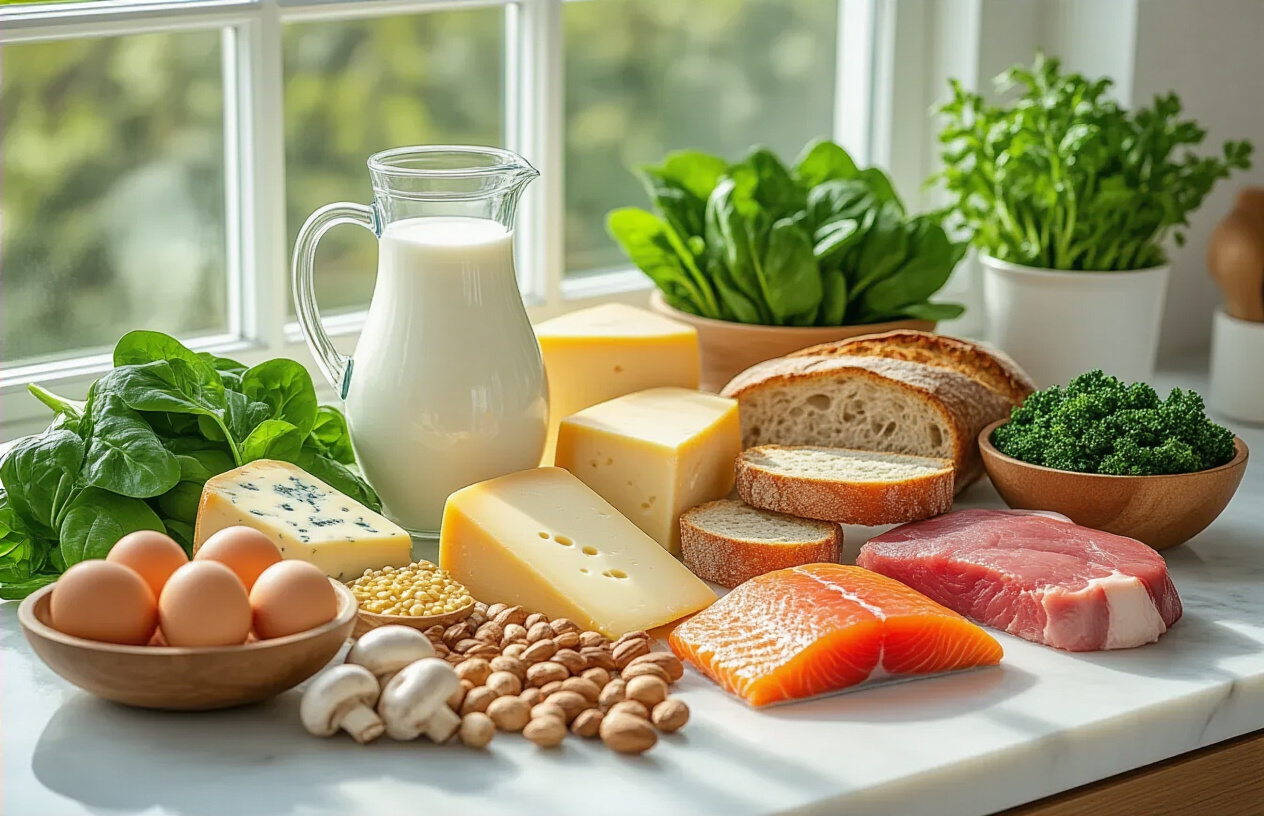
Maximize Riboflavin from Dairy Products and Eggs
Dairy products stand out as some of the most reliable sources of riboflavin in our diets. Milk contains approximately 0.45 mg of vitamin B2 per cup, which covers about one-third of your daily needs. Greek yogurt packs an even bigger punch with around 0.52 mg per cup, making it an excellent choice for breakfast or snacks. Cheese lovers can rejoice knowing that just one ounce of cheddar cheese provides about 0.11 mg of riboflavin.
Eggs deserve special recognition as riboflavin powerhouses. Two large eggs deliver roughly 0.5 mg of this essential vitamin, nearly meeting half your daily requirement. The riboflavin sits primarily in the egg white, so don’t skip that part when preparing your morning omelet.
For those watching their fat intake, low-fat dairy options maintain their riboflavin content while reducing calories. Skim milk contains virtually the same amount of vitamin B2 as whole milk, and low-fat yogurt remains an excellent source.
| Food Source | Serving Size | Riboflavin Content (mg) | % Daily Value |
|---|---|---|---|
| Greek Yogurt | 1 cup | 0.52 | 40% |
| Milk (any fat %) | 1 cup | 0.45 | 35% |
| Eggs | 2 large | 0.50 | 38% |
| Cheddar Cheese | 1 oz | 0.11 | 8% |
Harness Plant-Based Sources Including Leafy Greens and Legumes
Plant-based eaters have plenty of options for meeting their riboflavin needs. Dark leafy greens like spinach and collard greens contain solid amounts of vitamin B2, with one cup of cooked spinach providing about 0.42 mg. Asparagus stands out among vegetables, offering 0.18 mg per cup when cooked.
Legumes bring both protein and riboflavin to your plate. Lima beans lead the pack with 0.16 mg per half cup, while black beans and lentils each contribute around 0.10 mg per half-cup serving. These versatile ingredients work perfectly in soups, salads, and main dishes.
Nuts and seeds add crunch along with their riboflavin content. Almonds provide about 0.28 mg per quarter cup, making them perfect for snacking or adding to yogurt. Sunflower seeds offer similar benefits and work great as salad toppers.
Mushrooms deserve a special mention among plant sources. Portobello mushrooms contain about 0.49 mg per cup when grilled, rivaling many animal products. Cremini and shiitake mushrooms also provide decent amounts while adding umami flavor to your dishes.
Incorporate Fortified Cereals and Whole Grains into Your Diet
Fortified cereals can dramatically boost your daily riboflavin intake. Many breakfast cereals contain 25-100% of your daily vitamin B2 needs per serving. Check nutrition labels carefully, as fortification levels vary significantly between brands and products.
Whole grains naturally contain riboflavin, though in smaller amounts than fortified products. Brown rice provides about 0.04 mg per cup, while quinoa offers 0.11 mg per cup cooked. Oats contain roughly 0.14 mg per cup of cooked oatmeal, making your morning bowl more nutritious than you might realize.
Enriched bread and pasta products have riboflavin added back after processing. Two slices of enriched bread typically provide about 0.12 mg, while a cup of enriched pasta contributes around 0.15 mg to your daily intake.
| Grain Source | Serving Size | Riboflavin Content (mg) | Notes |
|---|---|---|---|
| Fortified Cereal | 1 cup | 0.43-1.7 | Varies by brand |
| Quinoa (cooked) | 1 cup | 0.11 | Complete protein bonus |
| Oatmeal (cooked) | 1 cup | 0.14 | Heart-healthy fiber |
| Enriched Pasta | 1 cup | 0.15 | Check labels for fortification |
Nutritional yeast has become popular among plant-based eaters as a cheese substitute, and for good reason beyond taste. Just two tablespoons provide an impressive 9.6 mg of riboflavin – that’s over seven times your daily requirement. This makes it one of the most concentrated sources available.
Recognize Signs Your Body Needs More Riboflavin

Spot Early Warning Signs of B2 Deficiency
Your body sends clear messages when riboflavin levels drop too low. The most noticeable early signs often appear around your mouth and eyes. Cracks at the corners of your mouth, called angular cheilitis, frequently develop first. Your lips might become red, swollen, or develop painful fissures that refuse to heal.
Eye problems signal another major warning. You might experience increased sensitivity to bright lights, making it uncomfortable to be outdoors on sunny days. Your eyes may feel gritty, burn, or water excessively. Some people notice their vision becomes blurry, especially when trying to focus on close objects.
Skin changes also indicate low riboflavin levels. Your skin might develop a greasy, scaly appearance, particularly around your nose, ears, and eyelids. A red, sore tongue that appears smooth or swollen represents another telltale sign. Hair loss, though less common, can occur in severe cases.
Fatigue and weakness often accompany these physical symptoms. You might feel tired even after adequate sleep, or notice your energy levels dropping throughout the day. Some people experience mood changes, including increased irritability or depression.
Understand Risk Factors That Increase Your Riboflavin Needs
Certain lifestyle factors and health conditions significantly raise your riboflavin requirements. People who consume excessive alcohol face the highest risk since alcohol interferes with riboflavin absorption and increases excretion through urine. Regular alcohol consumption can deplete your body’s stores quickly.
Individuals following restrictive diets often struggle to meet riboflavin needs. Vegans and vegetarians must pay special attention since many rich sources come from animal products. Those avoiding dairy products lose access to one of the most abundant riboflavin sources.
Medical conditions affecting digestion create absorption problems. Inflammatory bowel disease, celiac disease, and chronic diarrhea prevent proper nutrient uptake. People taking certain medications, including some antibiotics and psychiatric drugs, may require additional riboflavin.
Pregnancy and breastfeeding dramatically increase riboflavin needs. Your body requires extra amounts to support fetal development and milk production. Athletes and physically active individuals also need more riboflavin to support increased energy metabolism.
Age plays a role too. Older adults often have reduced absorption capacity and may take medications that interfere with riboflavin utilization. People living in areas with limited access to fresh, nutrient-rich foods face geographical challenges.
Identify When Professional Medical Evaluation Becomes Necessary
Persistent symptoms warrant professional attention, especially when multiple warning signs appear together. Schedule a medical evaluation if mouth sores, eye problems, and fatigue continue for more than two weeks despite dietary improvements.
Severe symptoms require immediate medical care. Seek professional help if you experience significant vision changes, widespread skin problems, or extreme fatigue that interferes with daily activities. These signs might indicate advanced deficiency requiring supervised treatment.
Blood tests provide definitive answers about your riboflavin status. Healthcare providers can measure riboflavin levels directly or assess related enzyme activity. These tests help distinguish between true deficiency and symptoms caused by other conditions.
Medical evaluation becomes critical for people with chronic health conditions or those taking multiple medications. Your doctor can determine whether your symptoms stem from riboflavin deficiency or represent side effects from other treatments.
Don’t delay seeking help if you’re pregnant, breastfeeding, or caring for young children showing potential deficiency signs. These vulnerable populations need prompt professional assessment to prevent complications.
Healthcare providers can also recommend appropriate supplementation strategies and monitor your progress. They’ll help you avoid potential interactions with other nutrients or medications while ensuring safe, effective treatment.
Address Special Dietary Requirements for Vulnerable Populations
Pregnant women need approximately 1.4 milligrams of riboflavin daily, increasing to 1.6 milligrams during breastfeeding. Focus on incorporating milk, yogurt, and leafy greens into meals. Prenatal vitamins typically provide adequate amounts, but whole food sources offer additional benefits.
Infants and children require careful attention to riboflavin intake. Breast milk naturally provides sufficient amounts for newborns, while formula-fed babies receive fortified nutrition. Toddlers benefit from whole milk, cheese, and fortified cereals. Picky eaters might need creative meal planning to ensure adequate intake.
Elderly adults face unique challenges requiring modified approaches. Choose easily digestible sources like milk, soft cheeses, and fortified cereals. Consider liquid supplements if chewing becomes difficult. Regular meals help maintain consistent nutrient intake throughout the day.
Athletes and highly active individuals need increased amounts to support energy metabolism. Include riboflavin-rich foods in pre and post-workout meals. Chocolate milk provides an excellent recovery drink combining riboflavin with protein and carbohydrates.
People following plant-based diets should emphasize fortified foods, nutritional yeast, and leafy green vegetables. Almonds, mushrooms, and fortified plant milks help bridge nutritional gaps. Consider B-complex supplements if blood tests reveal low levels.
Individuals with digestive disorders may need higher intake amounts or specialized forms of riboflavin. Work with healthcare providers to develop personalized nutrition plans addressing both the underlying condition and nutrient needs.
Optimize Your Daily Riboflavin Intake Safely
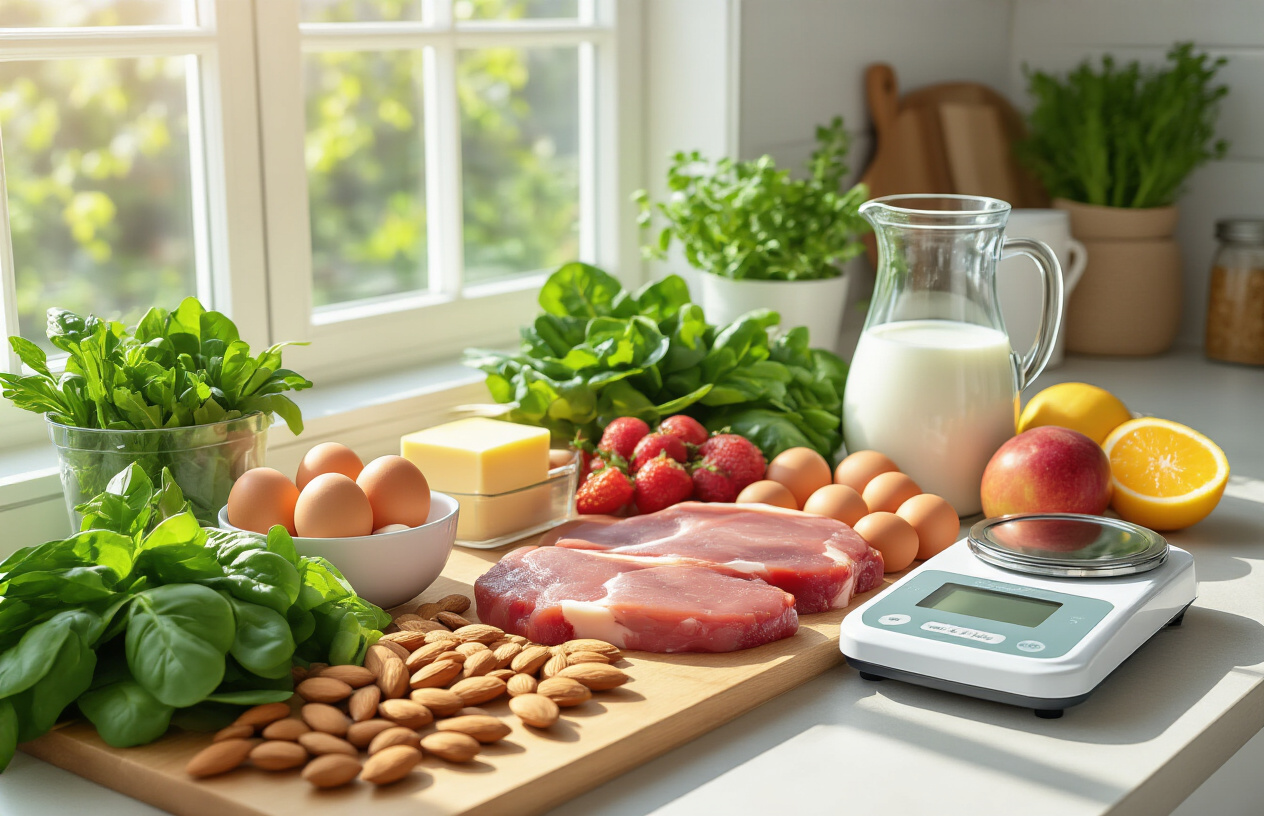
Meet Recommended Daily Values for Different Age Groups
Your riboflavin needs change throughout your life, and getting the right amount depends on several factors including age, gender, and life stage. Adults typically need about 1.1-1.3 mg daily, but the specifics matter more than you might think.
Women need approximately 1.1 mg daily, while men require slightly more at 1.3 mg. During pregnancy, this requirement jumps to 1.4 mg daily, and breastfeeding mothers need even more – about 1.6 mg to support both their own needs and milk production.
Children have lower requirements that gradually increase with age:
| Age Group | Daily Riboflavin Requirement |
|---|---|
| 1-3 years | 0.5 mg |
| 4-8 years | 0.6 mg |
| 9-13 years | 0.9 mg |
| 14-18 years (males) | 1.3 mg |
| 14-18 years (females) | 1.0 mg |
Older adults often need special attention to their riboflavin intake. Age-related changes in digestion and medication use can affect absorption, making it important to monitor intake through food choices or discuss supplementation with healthcare providers.
Athletes and people with high physical activity levels may benefit from slightly higher amounts due to increased energy metabolism, though this rarely requires dramatic increases beyond normal dietary sources.
Choose Between Food Sources and Supplement Options
Food sources remain the gold standard for meeting riboflavin needs. Whole foods provide not just riboflavin but also complementary nutrients that work together for better absorption and utilization. Dairy products, lean meats, leafy greens, and fortified cereals typically provide abundant riboflavin in easily absorbed forms.
Supplements become valuable when dietary intake consistently falls short or when specific health conditions interfere with absorption. Riboflavin supplements are generally safe and well-tolerated, but they’re not always necessary if you eat a varied diet.
Best food-first approach:
- Include dairy products like milk, yogurt, or cheese daily
- Add leafy greens to at least one meal
- Choose fortified cereals occasionally
- Include lean meats or fish several times weekly
When to consider supplements:
- Restrictive diets (vegan, dairy-free)
- Digestive disorders affecting absorption
- Chronic illness or medication interference
- Consistently low dietary intake despite efforts
Riboflavin supplements are available as standalone products or within B-complex formulations. B-complex vitamins often work better together, making these combination supplements a practical choice for many people.
Avoid Potential Interactions with Medications and Other Nutrients
Riboflavin generally plays well with other nutrients, but some medications and substances can interfere with its absorption or increase your body’s need for it. Being aware of these interactions helps you maintain optimal levels.
Certain medications can deplete riboflavin or interfere with its function:
Medications that may affect riboflavin:
- Tricyclic antidepressants
- Phenothiazine antipsychotics
- Some antimalarials
- Probenecid (gout medication)
- Oral contraceptives (may slightly increase needs)
Alcohol consumption significantly impacts riboflavin status. Regular alcohol use increases riboflavin requirements and can interfere with absorption. People who drink alcohol regularly should pay extra attention to their riboflavin intake through food sources.
Positive nutrient interactions:
- Works synergistically with other B vitamins
- Supports vitamin B6 and folate function
- Enhanced absorption when taken with food
- Iron absorption may improve with adequate riboflavin
Light exposure destroys riboflavin, so avoid taking supplements in clear containers exposed to bright light. This same principle applies to storing riboflavin-rich foods.
Store and Prepare Riboflavin-Rich Foods for Maximum Retention
Riboflavin is surprisingly fragile, and poor storage or cooking methods can dramatically reduce the amount you actually get from your food. Light is riboflavin’s biggest enemy – it breaks down quickly when exposed to sunlight or bright artificial light.
Storage strategies that preserve riboflavin:
- Store milk in opaque containers or keep in dark refrigerator areas
- Choose cardboard milk cartons over clear plastic when possible
- Keep leafy greens in refrigerator crisper drawers away from light
- Store grains and cereals in dark, cool pantries
- Use riboflavin-rich foods within their optimal freshness periods
Cooking methods make a huge difference in riboflavin retention. Water-soluble vitamins like riboflavin easily leach into cooking water, so preparation techniques matter.
Cooking tips for maximum retention:
- Steam vegetables instead of boiling when possible
- Use minimal water when cooking grains or vegetables
- Save and use cooking liquid in soups or sauces
- Avoid long cooking times at high temperatures
- Choose quick cooking methods like stir-frying or microwaving
Raw preparations often provide the highest riboflavin content. Fresh salads, smoothies with leafy greens, and minimal processing help preserve this sensitive vitamin. When you do cook, shorter cooking times with less water exposure will help you keep more of the riboflavin that makes these foods valuable for your health.

Riboflavin plays a crucial role in keeping your body running smoothly, from converting food into energy to maintaining healthy skin and vision. Getting enough of this essential B vitamin doesn’t have to be complicated – dairy products, leafy greens, eggs, and fortified cereals can easily help you meet your daily needs. Pay attention to warning signs like fatigue, skin problems, or eye sensitivity, as these might signal you need to boost your intake.
Start making small changes today by adding riboflavin-rich foods to your meals and snacks. Your body will thank you for the extra energy and vitality that comes with proper nutrition. Remember, consistency matters more than perfection when building healthier eating habits that support your long-term wellness.




